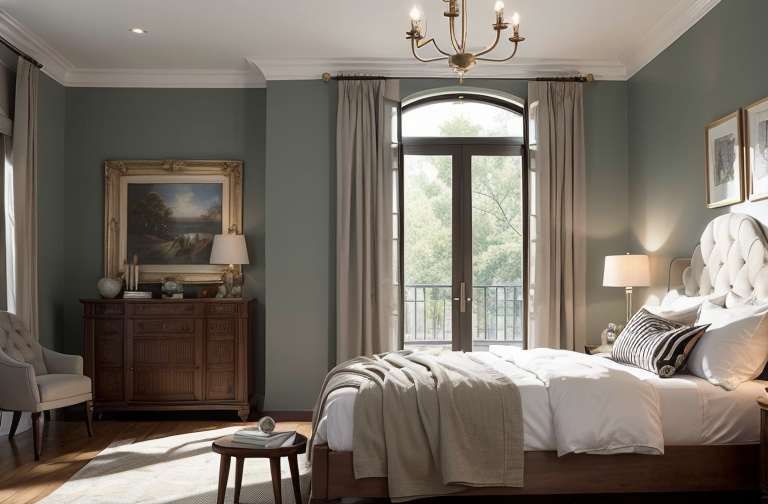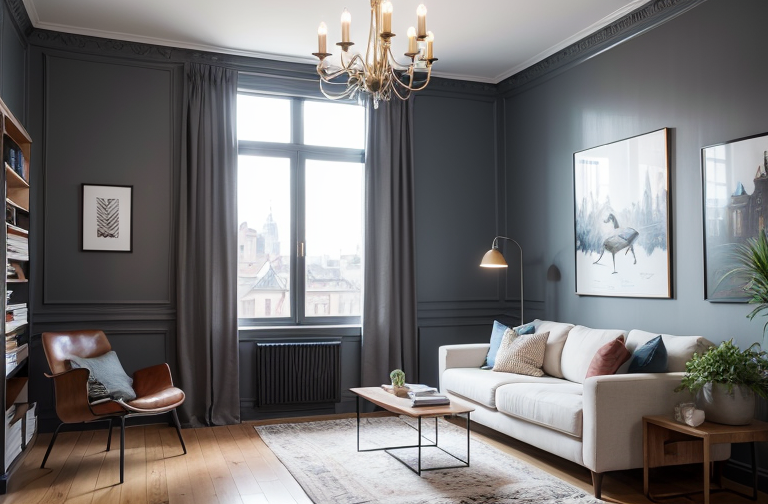Unveiling the Key Elements of Minimalist Interior Design: From Negative Space to Natural Elements

Explore minimalist interior design which emphasizes simplicity and functionality, using clean lines, open spaces, and neutral colors. Master the art of applying negative space, minimal decorations, and natural elements.
The Essence of Minimalist Interior Design
Hello there, Emma Harrison here! I hold a special appreciation for the art of living with less, a concept deeply portrayed in what is popularly referred to as minimalist interior design.
Definition of Minimalist Interior Design
In my years of schooling at Parsons and exploring various design movements, I learned that modern minimalist interior house design emphasizes simplicity and functionality above all. It’s in essence, a celebration of space, where less is indeed more. Everything from the furniture to the decor in a minimalist setting is purposefully selected to serve some functionality while at the same time imbuing a sense of calm and serenity in the environment.
Key Characteristics of Minimalist Design
As an interior designer, I take joy in investing in fewer, quality pieces brimming with clean lines and open spaces, hallmarks of minimalist design. There’s a sublime beauty in restraint, in meticulously curating every piece and allowing the space to breathe. The result is a harmonious interior that embodies practicality and aesthetics. I find the incorporation of large artworks, simple displays, and natural light particularly entrancing. They tie together the room, invoking a sense of spaciousness unique to minimalist interior design.
Impact on Day-to-Day Living
Minimalist design has had a profound impact on my day to day living. With fewer but deliberate elements in my personal space, my environment feels less cluttered. This, remarkably, translates into a less cluttered mind, inviting in peace and tranquillity. Crafting interiors that not just appeal to the eyes, but impact the way of life is a thrilling journey that I relish as an interior design professional. Minimalist design takes this a notch higher and challenges us to redefine the true essence of a home.

Techniques in Minimalist Interior Design
Minimalism offers me a chance to infuse a simple modern house interior design living room with an exquisite balance of practicality and aesthetics. It’s a delicate dance between what to keep and what to let go.
Utilization of Negative Space
Mastering this design style means appreciating the essence of negative space—intentional empty pockets that allow the room to breathe. It’s less about emptiness and more about creating focal points. The absence of clutter highlights the splendors of the unique pieces we choose to display, allowing them to shine instead of getting lost in the noise.
The Role of Functionalities in Design
Then, we have functionality—a key pillar of minimalist design. Each object that graces a room under this design umbrella earns its place through practical use. This calls for cleverly designed furniture and decor that offer multiple purposes. For instance, a sleek wall mounted shelf doubles as a display unit and a storage solution, reducing the quantity of items in the room while boosting usefulness.
Integration of Natural Elements
Embracing minimalist design involves creating depth and character in a room through the integration of natural elements. Wood, plants, metals—they all add a touch of raw, organic beauty to an otherwise simplistic space. I adore the understated charm of a wooden coffee table, or a leafy green plant perched on a metallic stand—these elements breathe life into a minimalist setting.
The beauty of minimalist interior design lies in its ability to marry together simplicity, functionality, and a touch of nature, perfectly resonating with my design ethos and methodologies. Crafting a minimalist sanctuary is not simply about subtracting—it’s about careful curation and intentional decision making. And that to me, is the art of minimalism in design.

Color and Decoration Scheme in Minimalist Interior Design
When I think about minimalist interior design, I’m immediately drawn to the calming serenity of neutral colors. It’s no wonder that New England house interior design, where comfort and warmth are emphasized, often incorporates these subtle shades. There’s simply something about whites, creams, and pastels that create a tranquil atmosphere, instantly putting anyone who enters at ease. 🕊️
Emphasis on Neutral Colors
Certainly, a minimalist interior is not devoid of color, but rather harnesses the power of neutrality. Palettes that consist of whites, creams, and pastels hold a kind of transforming magic, painting an air of calmness that swathes the entire space. These colors bring out the beauty of form, allowing each element in the room to shine in its own light.
The Merit of Minimal Decorations
Additionally, a cornerstone of minimalism pivots on fewer, but purposeful decorative pieces. Each carefully selected object plays a central role in creating focal points within the space. Rest assured, when you enter my clients’ homes, you’re not stepping into a stark environment, but one that emphasizes beauty in simplicity.
Impact of Lighting in the Overall Design
Lighting in minimalist design should make the space feel warm, cozy and airy. Natural sunlight is our best friend. It brings life to a room, casting enchanting shadow plays on the walls, and adds another layer of depth to your space. Remember, even minimal interiors can glow with warmth and welcoming allure.
Minimalist design involves skillful blending of neutral colors, minimal, purposeful decorations and strategic lighting. The goal: an inviting abode that doesn’t skimp on style but exudes tranquility and comfort. Simple, yet deeply profound.

The Importance of Open Space and Storage in Minimalist Design
In Minimalist design, open space is crucial for a clean and uncluttered look, emphasizing simplicity and functionality. Efficient storage solutions play a pivotal role, ensuring a harmonious balance between the aesthetic appeal of open spaces and the practicality of storage within a minimalist setting.
Relevance of Open Space in this Design Style
As an interior design enthusiast, let me share how I perceive open space in minimalist design. Space isn’t just a vacuum waiting to be filled in. It serves like the white canvas of a painter, inviting possibilities for creativity and innovation. In the world of modern minimalist house design interior, an open space is vital. It allows for energy to flow freely and invites natural light to penetrate the home, forming harmonious connections between the elements in a living space.
The Role of Efficient Storage Solutions
Nothing disrupts the soothing tranquillity of a minimalist design quite like clutter. Thus, storage is a silent hero in the story of minimalist interior design. It is all about finding creative solutions to keep an organized, neat look. Be it in wall shelves or hidden spaces, the idea is to have items tucked away from the eye without compromising the functionality of the house.
Balance Between Open Space and Storage
The dance between open space and storage forms the essence of a minimalist design. Achieving balance is key. The spaces must breathe with openness, yet also respect the need for storage. Similarly, storage cannot overtake the simple serenity that open spaces bring to minimalist design. When achieved, this delicate balance ensures a clutter free environment that radiates tranquillity and grace. It demonstrates beauty isn’t always about adding; sometimes it’s about knowing when to take away. It’s a testament to the artistry of designing a space that perfectly blends utility with aesthetics.
Key Takeaways on Minimalist Interior Design
Despite the intricate process, the essence of my passion lies at the core of every exciting design workshop – unraveling the beauty that lies in simplicity. Aesthetics and functionality synergize, Forming the backbone of a modern minimalist interior house design.
Benefits of a Minimalist Interior Design
The charm of a minimalist design emerges from how beautiful simplicity can be. A minimalist aesthetic champions few, but meaningful elements. It encourages us to free our spaces of clutter for a clean, streamlined arrangement. This design style promotes functionality while creating a calming atmosphere, underpinned by a sense of order and tranquillity. Picture a simple modern house interior design living room: the neutral palette, the strategic placement of objects and a sense of serenity that pervades it – that’s the power of minimalist design.
Things to Consider When Transitioning
Shifting towards a minimalist design is not merely about shedding items. It is equally about discerning what truly matters. You need to carefully select essentials that are not merely functional, but also embody your unique style and persona. It requires intricate planning that mirrors the charm of a New England house interior design rich but restrained, classy but cozy.
Success Factors in Achieving a Minimalist Interior Design
Most people erroneously believe that minimalist design is just about less. Less isn’t always more it’s about making more out of less. That’s the epitome of a modern minimalist house design interior. Success in this aesthetic palette relies on efficient utilization of storage – each object with a designated space, eradicating disorder. An intelligent amalgamation of natural elements, controlled lighting and negative space that whispers more than it screams, coats the milieu with an organic, breathable grace.
Ultimately, minimalist interior design is about cultivating a space that exudes harmony and resonates individuality. It’s about converting your house into a sanctuary where you can retreat, rest and reflect, away from the chaos of the world. This process can be a journey of self discovery and refinement, demonstrating how even simplicity can have layers.
- Unlocking the Intricacies of Interior Design: Ranch-Style Homes and the Pursuit of Functionality
- Blending Tradition and Modernity: Exploring the Design of Nipa Hut and Trynagoal Tea House
- Enhancing Dining Experiences through Creative Interior Design and Rebranding in Burger Restaurants
- Mastering Home Renovation: The Crucial Roles of an Interior Designer and Effective Budget Management
- Understanding the Value of Interior Designers: Roles, Benefits, and Selection Process
- Exploring the Richness of Turkish Architecture and Interior Design through Adobe Stock and Pinterest
- Unveiling the Unique Characteristics and Design Elements of Ranch-Style Houses
- Embracing Openness and Personal Touch: The California Ranch House Interior Design Concept
- Embracing Warm Minimalism: The Rise of Brown Tones in Interior Design
- Enhancing Your New Home: Key Elements and Strategies in Interior Design
- Unveiling the Art of Luxury Interior Design: Exploration of Materials, Individual Style and Inspiration from Pinterest
- 13 Easy and Affordable Tips to Spruce Up Your Home Decor
- Exploring the Rich History and Distinctive Features of Tudor Architecture
- Exploring British Home Interiors: From Historical Evolution to Modern Adaptation
- Traversing the World of Interior Design: From Designer Profiles to DIY Ideas and Future-ready Furniture
- Contemporary Home Refinement: Leveraging Exposed Brick Design and Affordable, High-Quality Furnishings
- Exploring the Warmth and Charm of Modern Rustic Interior Design
- Enhancing Duplex and Triplex Interiors: An In-Depth Guide to Style, Lighting, and Effective Use of Space
- Creating Your Dream Bathroom: A Comprehensive Guide to Designs, Functionality, and Material Selection
- Creating Your Personal Spa: Insights into Modern Bathroom Design Trends



